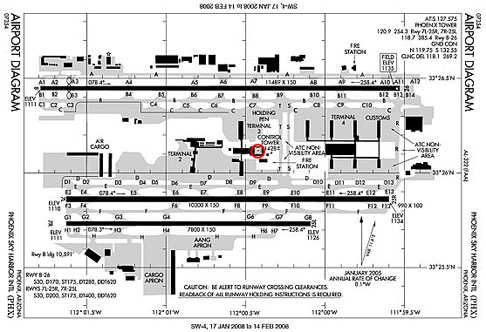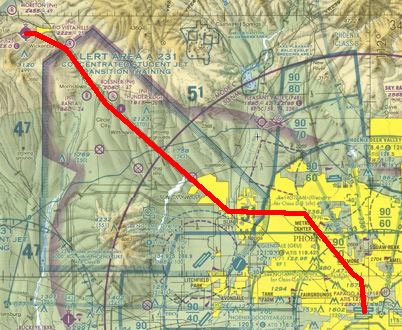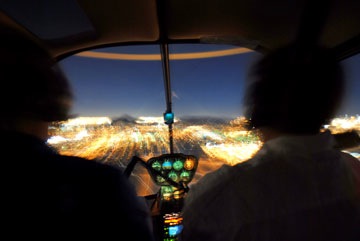A pickup at the Terminal 3 helipad.
Last week, I had my first passenger pickup at Sky Harbor’s Terminal 3 helipad. This was an unusual gig for several reasons:
- I’d only flown into the Terminal 3 helipad once before, and that was with a flight instructor. I’d asked for the flight so I could learn the approach in case I ever had to do it. A full year went by before I had a call for a pickup there.
- The Terminal 3 helipad is on top of Terminal 3 (hence the name), in an area that’s in the middle of the top level of a parking structure. To reach it, you have to cross one runway (from the north) or two runways (from the south) where commercial airliners are landing and taking off. (The airport diagram below shows its location beside the Control tower in the middle of this busy Class Bravo airport.)
- This particular pickup was at 8 PM. Since it was February, that means it was night.

So I was going to land at a helipad I’d landed on only once before, at the top of a 6-story building, in the middle of busy airport, at night.
The terminal 3 helipad is far more convenient for my passengers than where I usually land on the southwest corner of the airport at one of the FBOs. (I usually use Cutter, but Swift is there, too.) Landing at an FBO requires my passengers to get a free shuttle from their terminal to the FBO. You can’t beat the cost, but the amount of time you wait for the shuttle and then ride it takes away from the convenience of being picked up at Sky Harbor and whisked to your destination. My passengers were arriving via U.S. Airways (formerly America West), which had gates at Terminal 4. They’d still need to take a shuttle to meet me, but at least they didn’t have to go around the airport to do it.
The Flight
My passengers were supposed to land at 8:07 PM. I figured that by the time they got to the gate and retrieved their luggage, it would be at least 8:30. Then at least 15 minutes to get to me. Still, I don’t like to make people wait for me, so I decided to get there by 8:15 PM. That means I needed to start up at Wickenburg Airport by 7:30 or so.
Mike dropped me off. I’d pulled the helicopter out and fueled it up earlier in the day so it was sitting on a helipad, ready to go when we arrived. There was still a little glow to the west where the sun had set. Mike waited until I took off. Our friend Dave pulled up in his Jeep and chatted with him while I warmed up the helicopter. Then I took off, turning on the runway lights as I lifted off. I climbed to 3,000 feet and turned to the southeast where I could see the glow of Phoenix.
 My flight path would take me from the darkness of Wickenburg along Route 60 (Grand Avenue) to Bell Road. By then, I’d be in the brightness of the Phoenix area, flying at about 2,000 feet in over its lower elevations. I planned to turn east along Bell Road and follow that to I-17. I’d call Phoenix Tower from the Metro Center Mall at I-17 and Dunlap.
My flight path would take me from the darkness of Wickenburg along Route 60 (Grand Avenue) to Bell Road. By then, I’d be in the brightness of the Phoenix area, flying at about 2,000 feet in over its lower elevations. I planned to turn east along Bell Road and follow that to I-17. I’d call Phoenix Tower from the Metro Center Mall at I-17 and Dunlap.
Yes, I follow roads.
The flight worked just as I intended, although I did have to head southeast toward the mall sooner than I expected to avoid Deer Valley’s airspace. It wasn’t worth calling them for the 3 minutes I’d be in their space, so I just avoided it. My GPS made it easy to see where the space was so I didn’t slip in by mistake.
I’d been listening to Phoenix Tower talking to the incoming airliners since I was 20 miles out. I had nothing else to listen to. I’d purposely left my iPod behind so I wouldn’t be distracted by it. I don’t fly at night that often — maybe once or twice a month — and I was nervous about flying into the helipad at night.
I tuned my transponder to 0400. “Phoenix Tower, helicopter Six-Three-Zero-Mike-Lima is over Metro Center Mall, Sharp Echo with November for landing at the Terminal Three helipad.” This call to the tower identified me and my position, indicated that I was a signatory to the Sharp Echo letter of agreement for helicopter pilots, verified that I’d listened to the airport’s ATIS recording so I knew conditions, and state what I wanted.
The female controller’s voice came back in a moment. “Helicopter Zero-Mike-Lima, squawk zero-four-zero-zero and ident.”
She was telling me to tune my transponder as I already had and press the Ident button. That button makes my radar blip brighter than the others for a short time so she can see which blip I am.
“Zero-Mike-Lima is identing,” I said, pressing the button.
I was still quite a distance from her space, so I continued, now heading southeast. Hopefully, she’d see me and clear me to enter the class bravo airspace. But she didn’t. Instead, she gave some instructions to incoming airliners. I waited about two long minutes, then pressed the Ident button again, convinced that I was flying too low for her to see me.
“Helicopter Zero-Mike-Lima, say position again.”
“Zero-Mike-Lima is about three miles southeast of Metro Center.”
“Helicopter Zero-Mike-Lima, radar contact. Cleared into Class Bravo airspace. Proceed via Sharp Echo to midfield for crossing to Terminal Three helipad. Remain north of Runway Two-Six.” This call verified that the Tower could see me on radar and gave me the all-important clearance into the surface airspace. It also told me how I should proceed inbound: toward the airport, north of midfield.
I confirmed that I’d received the instructions by reading back the most important ones: “Zero-Mike-Lima proceeding. Will remain north of Runway Two-Six.”
I continued on my way, now looking for the airport. I was still at least ten miles out and all I could see were lights. After a while, I could see airplanes coming in for a landing and airplanes departing. I figured the airport had to be between them. My GPS confirmed that, but I really wanted to see where I’d be going.
I also wanted to see the tower. The Terminal Three helipad is less than 100 yards west of the tower. If I could see the tower, I could find the helipad. I wanted to make my approach directly to the helipad to minimize my time over the runway.
I heard the incoming jets talking with the tower as I continued in. One of them was being told to wait in the holding area. The pilot came on the radio and said, “Tower, we have a medical emergency and need to get to the gate immediately.” She cleared him to the gate.
I was three miles out and down to about 1500 feet when I saw the tower quite clearly. I adjusted my course. A moment later, the controller came on the radio again.
“Helicopter Zero-Mike-Lima, do you have that Airbus on short final in sight?”
“Zero-Mike-Lima has the traffic in sight.” How could I not? Two bright headlights were about a quarter mile from the runway end, closing on it quickly.”
“Helicopter Zero-Mike-Lima, cross behind that traffic and cleared to land at the Terminal Three Helipad.”
“Zero-Mike-Lima crossing the runway behind the traffic.”
I adjusted my speed to reach the runway just as the airbus passed by me and began my descent. I was already pretty low, so my descent wasn’t very steep. I crossed the runway with the quickest glance at the landing lights of about five more jets on their way in. I felt my cell phone vibrate and ignored it.
At first, I couldn’t see the helipad. I saw the rooftop parking structure and headed toward it. I was about 50 yards away when I saw the lighted helipad. I glided over to it and set down diagonally in the square, unsure of where my passengers would be coming from. I don’t like to park with the helicopter’s tail rotor facing where people might be walking or waiting.
It wasn’t until later that I saw the tri-colored rotating beacon in the southwest corner of the area that identified a civil aviation helipad. It was the first time I’d ever seen one.
On the Helipad
I cooled down the engine and shut down. A message on my cell phone was from my passengers. They’d landed but couldn’t get to the gate. It turned out that their gate had been handed over to a plane with a medical emergency. (I can’t make this stuff up.)
The terminal 3 helipad is a big, square landing area on top of the building. There’s enough room for one helicopter. If a helicopter is sitting on it, no one else can land on it. For that reason, a helicopter pilot who is parked there cannot leave the area.
Of course, I had my engine shut down and my radio off. If they needed me to move, they’d probably have to get someone out there to tell me. There was a security guy watching me for the first fifteen minutes or so of my wait. But then he got as bored as I did and, able to relocate, did.
I was aware of a few things up there. First, the smell of burning rubber. At first, it was so strong, I thought it was my helicopter. But then I realized it was the smell of the tires of the big planes heating up as they hit the tarmac on landing. The wind was blowing the smell from the south runways right to me. Not long afterward, I started smelling their brakes, too.
I was also aware of how nice the view is from up there. Great view of most runways. Phoenix skyline off to the northwest. The lights of Phoenix’s urban sprawl spread out in every direction around me, punctuated by blackness where rocky mountains rose too steeply to build upon. The antennas atop South Mountain looking like so many floating red lights. A nice breeze blowing kept the air feeling fresh and clean (despite the tire/brake smell).
The helipad is an excellent place to hang out and watch traffic come and go. It was quite entertaining — at least for the first fifteen or twenty minutes. Then it got just plain boring. I spent some time tweeting updates on Twitter and reading what others were writing. The Oscars were on television and most folks seemed tuned into that.
After about 45 minutes, I called my passengers again. They’d retrieved their luggage and were now waiting for the van from the guest ranch they were staying at to come pick it up. I guess I should explain. There’s enough room in my helicopter for them and some small pieces of luggage, but not enough room for them and enough luggage for two people for two weeks. It turned out to be cheaper and easier to have the ranch send a van down for their bags than to book them on another charter carrier. This was also a good idea in case the weather turned bad and I couldn’t come get them at all. They could always take the van to the ranch. Why not just take the van? My client wanted to fly and he didn’t even care that he’d arrive at the ranch before his luggage. (Why can’t I have about 20 clients like that every season?)
I told them to have the van drop them off at Terminal 3 as it was leaving the airport. This would save them the hassle of catching the Inter-terminal shuttle bus. Then we hung up and I went back to waiting.
The Flight Back
My passengers arrived suddenly about 15 minutes later. I greeted them and bundled them on board, seating them both on the left side. I planned fly fly past downtown Phoenix on the way to Wickenburg, to give them a little night tour of the area. I started up and warmed up the engine, listening to the ATIS recording before switching to the tower frequency. I must have timed it just right because when I requested a departure to the northwest past downtown Phoenix, she immediately cleared me across the runway. I saw the landing lights of at least another five jets bearing down on us as I scooted across, climbing.
 After clearing the runway area, I turned to the west. The roof on Chase Field was open and there were some lights on in there. Maybe they were doing some kind of maintenance. I didn’t fly close enough to see. I turned north to follow 7th Street past the tall buildings, then headed northwest. I wanted to hook up with Grand Avenue again before we left the brightness of the city. This photo by Jon Davison gives you an idea of what it might have looked like from the back seat.
After clearing the runway area, I turned to the west. The roof on Chase Field was open and there were some lights on in there. Maybe they were doing some kind of maintenance. I didn’t fly close enough to see. I turned north to follow 7th Street past the tall buildings, then headed northwest. I wanted to hook up with Grand Avenue again before we left the brightness of the city. This photo by Jon Davison gives you an idea of what it might have looked like from the back seat.
The flight back was uneventful. As we reached Sun City and left the lights behind us, a sort of haze seemed to fill the cockpit. The first time I’d experienced this phenomena, it had scared me. Now I knew what caused it: my eyes adjusting to the lower light levels. I dimmed the cockpit’s instrument lights even more to prevent reflection on the inside of the bubble. My passengers were awed by the darkness we had to fly through.
Then we could clearly see the line of white that marked route 93: cars returning from Las Vegas on that Sunday night. They’d pass right through Wickenburg. We followed route 60 at an altitude of about 3,000 feet into town. Then I turned along the dark corridor of Sols Wash, keyed the mike button, and brought the airport lights to life. A while later, we were on the ground on one of the two helipads and Mike was driving up to give them a lift to the ranch and bring me home.
It was just after 10:00 PM.
This particular flight will be one of those that stays with me for a long time. Not because it was frightening or dangerous or beyond my skill level. It was none of those things. But it was a new experience that offered new and unique challenges. Any time I take on a reasonable challenge and succeed, I learn and become a better person.
And when it’s a flying challenge, I become a better pilot.
 By the time I got back from the can, I there were three helicopter loads waiting to fly. I started right up and let Mike and Brad load my first group of passengers. Here’s what it looked like from my seat; I took this photo with my Treo.
By the time I got back from the can, I there were three helicopter loads waiting to fly. I started right up and let Mike and Brad load my first group of passengers. Here’s what it looked like from my seat; I took this photo with my Treo. We got above the cloud tops at 3000 feet. At 3200 feet MSL, the clouds looked like a fluffy blanket of cotton with Vulture Peak, Twin Peaks, and, far to the south, the bulk of the White Tank Mountains sticking out the top. It was absolutely beautiful.
We got above the cloud tops at 3000 feet. At 3200 feet MSL, the clouds looked like a fluffy blanket of cotton with Vulture Peak, Twin Peaks, and, far to the south, the bulk of the White Tank Mountains sticking out the top. It was absolutely beautiful.